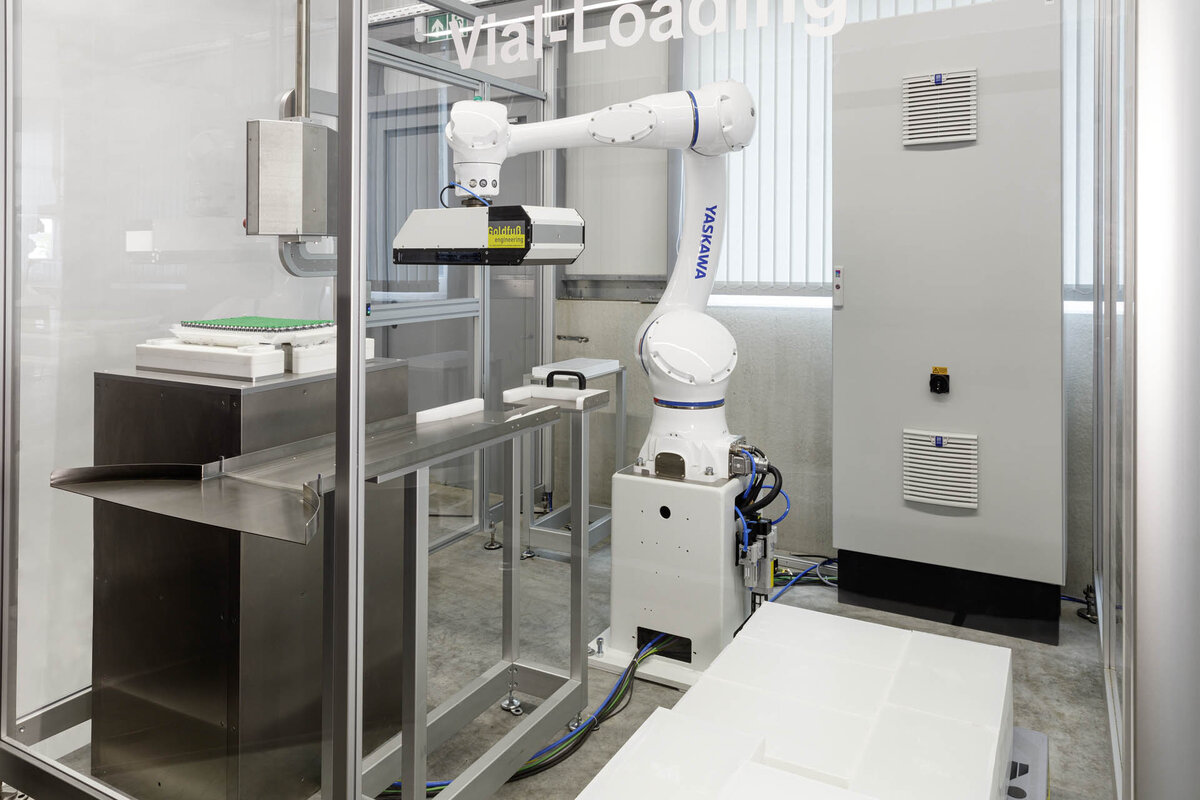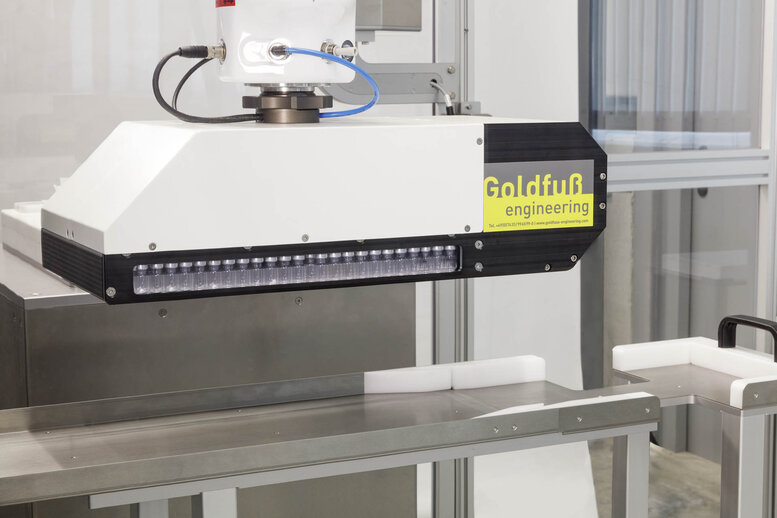Společnost Yaskawa nabízí portfolio produktů, díky kterým je předním výrobcem v oblasti měničů střídavého proudu, servopohonů, řídicí technologie a robotiky.
Goldfuß Engineering pioneers use of Yaskawa robots for handling sensitive vials
- Průmyslové odvětví
- AUTOMATIZACE LABORATOŘÍ
- Kient/ zákazník
- Goldfuß Engineering
- produkty
- HC20DTP - HC řada
- HC30PL - HC řada
Small bottles – major challenge
Some objects – under certain conditions – simply resist automation. That was hitherto the case with vials packed in plastic hollow boxes. These are small cylindrical medicine bottles, as used millions of times in the pharmaceutical industry. Goldfuß engineering has now solved the problem for once and for all: with a special gripper in combination with a Yaskawa Motoman robot.
Not least due to different clean room classes, in pharmaceutical production vials must pass through several handling steps. In particular, the feeding of empty vials into the washing or filling machine, or of filled vials into the inspection or packing machine, is usually still done manually.
The main reasons for this are to be found in the vials themselves: consisting of thin glass, they are extremely fragile. In addition, with sizes of only a few millilitres, they are very small. The limitations of conventional vacuum grippers are quickly reached. A further difficulty is that the vials are often transported in-house in sealable plastic hollow boxes, where they are positioned in no particular order. This poses special challenges when it comes to automation.

Automation solution from Goldfuß engineering
Goldfuß engineering GmbH, specialists in robot-assisted loading of packaging machines and user solutions in packaging technology and lab automation with headquarters in the German town of Balingen, has found a cutting-edge solution to his complex task for vials from a filling capacity as low as 2 ml (2R). In a compact handling cell a robot assumes the task of opening the plastic hollow box and loading the vials. Guided by a 3D camera system, it removes the boxes from the pallet. After opening the boxes, it automatically removes the vials and places them on a turntable or a bi-flow band, from which they proceed to the washing, filling, inspection or packaging machine. The robot then deposits the empty boxes in a container for subsequent disposal. The complete procedure takes around 50 to 60 seconds. This time can be significantly reduced through the use of a second robot.
Powerful entity of gripper and robot
The key component of this solution is a gripper that was specially developed by Goldfuß engineering for this application. Unlike a suction pad, for example, that does not enable a process-safe solution for 2R vials, this extremely compact gripper works mechanically and is at the same time product-friendly. This procedure ensures reliable take-up of the complete box contents, ensuring that all vials of a batch are accessed and loaded. If boxes of different sizes are to be handled, a greatly simplified format change is possible on customer request.
As a further option, the vials in the box can be automatically counted by a second camera for quality control, and the result reconciled with production data. In addition, the system can be connected to the customer’s network.

Partnership with Yaskawa
The gripper harmonizes perfectly with Motoman robots from Yaskawa. The two companies are linked by a long partnership. Goldfuß engineering has been a system partner to the manufacturer for many years. In its slimmest and simplest design, the gripper weighs in at 12 kg, plus vials. Diverse functional options in the gripper, such as cutting open a lid clip, can increase the weight of the gripper. In this case, a manipulator with a lifting capacity of 20 kg or more is recommended.
Yaskawa’s Motoman GP series of high-performance industrial robots are ideal for the purpose, although many pharma users prefer the HRC-capable cobots of the HC series, available with a payload of 20 or even 30 kg.
Industrial robots of the Motoman GP FGG series
GP stands for “General Purpose” and thus for a variety of applications. The Motoman GP series of 6-axis robots are implemented in the high protection class IP67 (especially protected against penetration of liquids and dust). They can be used under harsh working conditions and are very easy to clean. The robot can work without restriction in any installation position, the robot cable being inserted either laterally or through the socket. The integrated media supply in the axes optimizes the design of grippers and ensures the highest degree of reliability in subsequent operation.
Designed for tasks in secondary and tertiary packaging, the Motoman GP FGG series includes robots specially designed for the food sector. They use appropriately approved lubricants (Food Grade Grease) and feature a drip-proof, cleaning-resistant design. Thus they also ensure problem-free draining of liquids and can be used in direct contact with a wide range of foods and beverages.
Robots of the GP series are controlled by the latest high-performance YRC1000micro controller. Either the classical or the innovative smart pendant can be used for operation and programming. Alternatively, the robot can be integrated directly into a higher-level machine control via PLC function blocks (MotoLogix). In terms of connectivity (I/O, Process and Industry 4.0), interfaces as well as conveyor belt, camera and sensor connection, Motoman GP robots benefit from all versatile properties, tools and options of the compact Yaskawa standard robot controller.
Yaskawa HC20DTP and HC30PL cobots
Yaskawa HC20DTP and HC30PL cobots likewise conform to dust- and watertight protective class IP67. Programming of the cobots is simple, thanks to the advanced smart pendant control unit: Smart Pattern Wizard software guides the user through individual steps for creating different palletizing patterns. Using only a few reference points and pattern information, the Wizard creates a robot program that is still easy to edit in the Wizard. Those who prefer traditional programming and professional tools may do so using the teach pendant and extensive PalletSolver software.
First installation under construction
An installation for loading vials onto a packaging line using a HC20DTP cobot was already on display at the trade fair Interpack 2023. A further set-up with a Motoman GP50 FGG is under construction at the German facility of an international pharmaceutical company.























